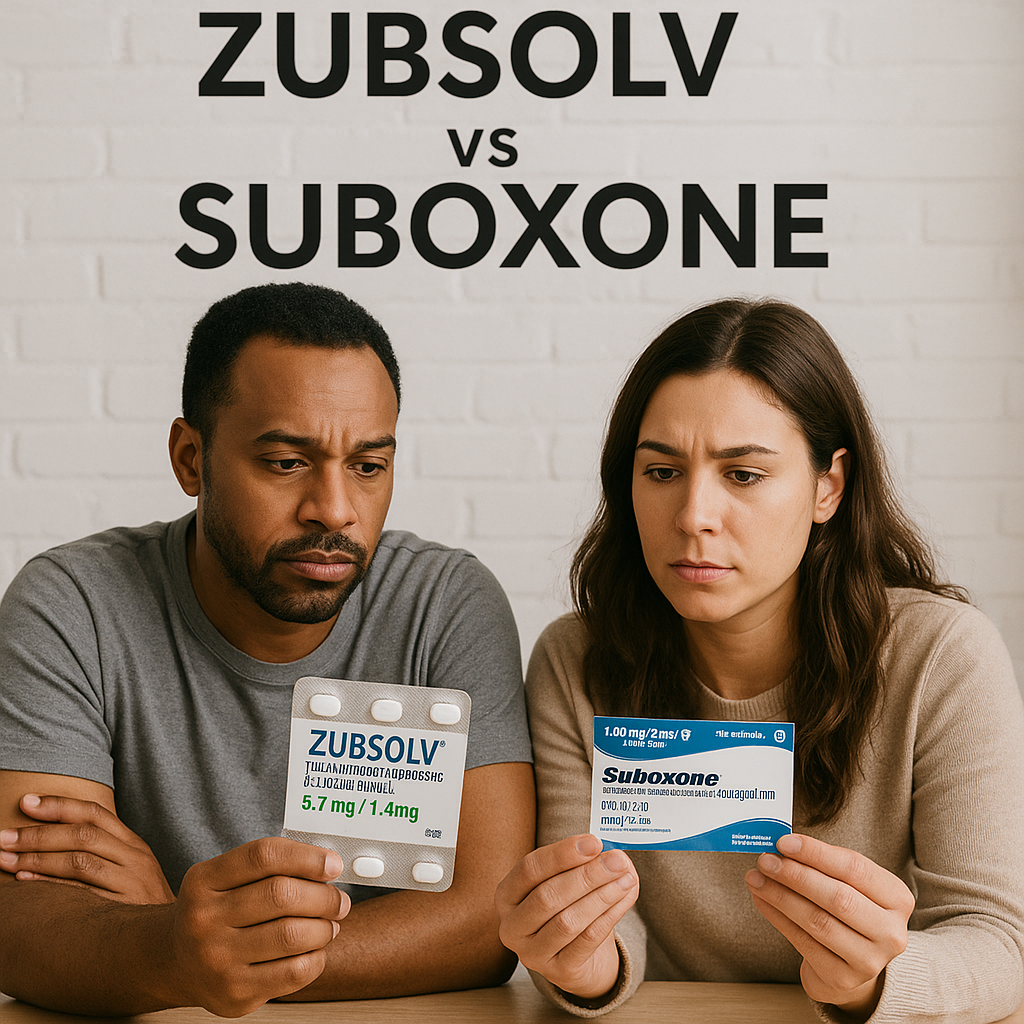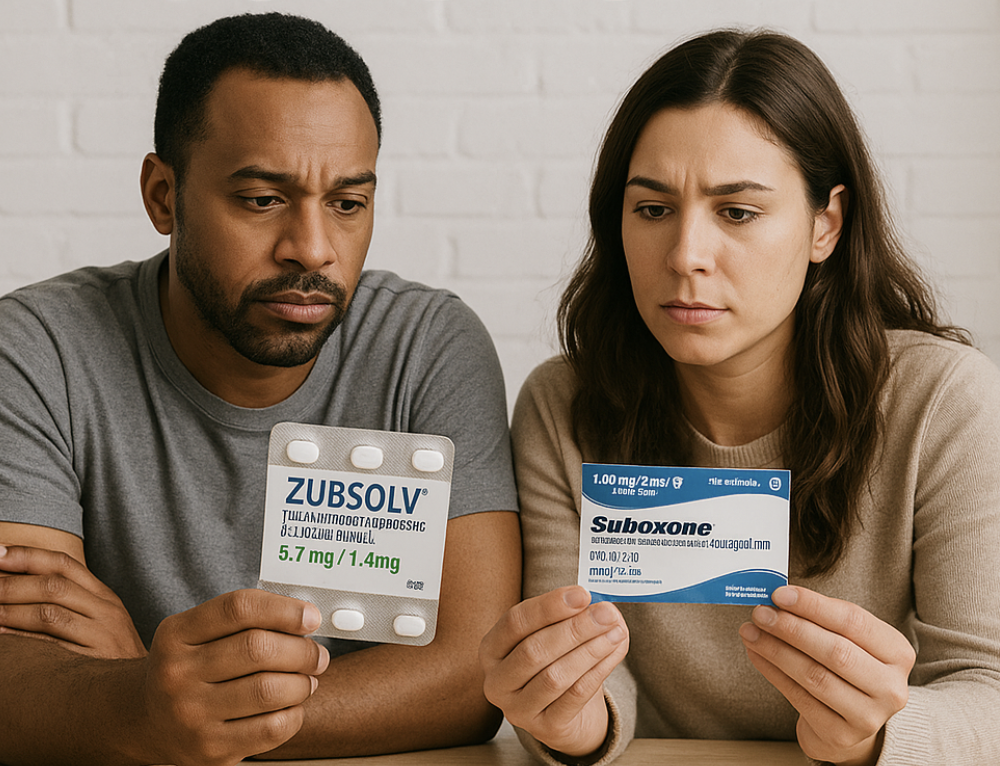Choosing between Zubsolv vs Suboxone for opioid use disorder? Both contain buprenorphine and naloxone but differ in formulation, absorption, and cost. This article breaks down these differences to help you make an informed choice regarding Zubsolv vs Suboxone.
Key Takeaways
- Zubsolv and Suboxone both contain buprenorphine and naloxone but differ in formulation, absorption rates, and dosage strengths.
- Zubsolv offers higher bioavailability and is generally more palatable due to its smaller, flavored tablets, making it a preferred choice for many patients.
- The choice between Zubsolv and Suboxone should be based on individual patient needs, treatment goals, and considerations of cost and insurance coverage.
What is the difference between Zubsolv and Suboxone?
Zubsolv and Suboxone are both suboxone brand-name medications designed to treat opioid use disorder (OUD). They share a common goal: to help individuals overcome addiction by reducing withdrawal symptoms and cravings. Both medications contain a combination of buprenorphine and naloxone, but they differ significantly in their formulation, absorption rates, and availability.
Buprenorphine is a partial opioid agonist that activates opioid receptors in the brain, thereby alleviating withdrawal symptoms and cravings without inducing the same level of euphoria as other opioids. Naloxone, on the other hand, is an opioid antagonist that blocks the effects of opioids, deterring misuse. These components work together to provide a balanced approach to treating OUD with buprenorphine naloxone in mg buprenorphine.
The choice between Zubsolv and Suboxone is crucial for both patients and healthcare providers, as the right medication can significantly impact treatment outcomes and overall quality of life. Understanding the differences between these medications is the first step in making an informed decision.

Zubsolv vs Suboxone: Key similarities and differences
When comparing Zubsolv and Suboxone, it’s essential to understand their key similarities and differences:
- Both medications contain the same active ingredients—buprenorphine and naloxone.
- Zubsolv is exclusively offered as an orally disintegrating tablet.
- Suboxone is available in both film and tablet forms.
Zubsolv offers several advantages compared to Suboxone:
- Six dosage strengths compared to Suboxone’s four, providing more options for dosing.
- Flexibility that can be particularly beneficial for fine-tuning treatment to individual patient needs.
- Significantly higher doses of bioavailability, meaning Zubsolv is absorbed more effectively by the body.
Patients often prefer Zubsolv because its formulation masks the bitter taste of its ingredients, making it more palatable than Suboxone. The smaller doses of the Zubsolv tablet also contribute to ease of use.
Despite these differences, both medications are classified as Schedule III controlled substances due to their potential for dependence, including the risk of suboxone addiction in cases of prolonged or unsupervised use. The newer formulation of Zubsolv, which lacks generic forms, tends to be more expensive than Suboxone.
When considering patient preference, taste, size, cost, and mg, these factors all play a significant role in choosing the right medication.
How Zubsolv works
Zubsolv operates by binding to opioid receptors in the brain, which helps alleviate withdrawal symptoms without inducing the same level of euphoria associated with other opioids. This dual action is facilitated by its two main components: buprenorphine and naloxone.
Buprenorphine, a partial opioid agonist, activates opioid receptors but does so less intensely than full agonists like heroin or morphine. This activation helps to reduce cravings and withdrawal symptoms. Buprenorphine 1.4 mg naloxone, an opioid antagonist, is included to counteract the euphoric effects of opioids, making it less likely to be abused. The impact of naloxone in Zubsolv lasts only 30 to 60 minutes, ensuring that withdrawal symptoms are managed without significant highs. Additionally, mg naloxone plays a crucial role in this formulation.
Zubsolv’s unique formulation offers several benefits:
- Rapid absorption under the tongue, enhancing its effectiveness compared to other methods of administration.
- The sublingual tablet form is designed to be completely dissolved quickly, ensuring efficient absorption.
- This rapid absorption allows the medication to start working swiftly, providing relief from withdrawal symptoms.
Additionally, Zubsolv tablets are flavored with mint and are smaller in size, which improves patient compliance. These features make taking Zubsolv a more pleasant experience, encouraging adherence to the treatment regimen, and patients may find themselves seeking more zubsolv.
How Suboxone works
Suboxone combines buprenorphine, a partial opioid agonist, with naloxone, an opioid antagonist, to treat opioid addiction effectively. Buprenorphine mimics opioids by activating opioid receptors in the brain, reducing cravings and withdrawal symptoms without producing intense euphoria. Naloxone blocks the effects of opioids, discouraging misuse by inducing withdrawal symptoms if the medication is injected.
Suboxone is available in both sublingual tablet and sublingual film forms, which dissolve under the tongue or on the cheek. Key points include:
- The administration method impacts the onset of action and absorption.
- The film typically dissolves faster than the tablet.
- This flexibility allows healthcare providers to choose the most suitable form for patients based on their preferences and needs.
One of the key benefits of buprenorphine in Suboxone is its ceiling effect, meaning that after a certain dose, increasing it will not significantly enhance its effects. This feature provides a safety advantage over full opioid agonists, reducing the risk of overdose. Furthermore, buprenorphine’s slow dissociation from the mu-opioid receptor helps maintain drug levels in the system, resulting in longer-lasting effects and a lower potential for misuse.
Suboxone must be administered in a controlled setting with support from healthcare providers to ensure proper use and effectiveness. This structured approach helps patients stabilize during treatment, reducing the risk of relapse and enhancing overall outcomes.
Zubsolv vs Suboxone: Effectiveness and clinical outcomes
Both Zubsolv and Suboxone are recognized as effective treatments for opioid use disorder, particularly when included in a comprehensive treatment plan involving counseling. Zubsolv offers higher bioavailability compared to Suboxone, meaning that a smaller dose of Zubsolv can achieve the same effects as a larger dose of Suboxone.
Clinical studies have shown the following about Zubsolv compared to Suboxone film for treating opioid dependence:
- Zubsolv is equally effective as Suboxone film.
- Zubsolv requires a 29% lower dose for the same efficacy.
- The ISTART study, one of the largest to assess buprenorphine treatments, demonstrated no significant difference in treatment retention rates between Zubsolv and Suboxone after 15 days.
- Both medications showed similar patient outcomes.
- Both medications showed improvements in withdrawal symptoms and cravings, as measured by the Clinical Opiate Withdrawal Scale and other assessment tools.
Patients and physicians reported comparable levels of improvement in treatment outcomes using both Zubsolv and Suboxone, indicating equivalent clinical effectiveness. The onset of action for Zubsolv occurs within 60 minutes, while Suboxone generally starts to work within 20 to 60 minutes after administration. This rapid onset helps patients manage withdrawal symptoms more effectively.
Overall, both medications have shown high efficacy in reducing withdrawal symptoms and cravings, making them valuable options for treating opioid use disorder.
Side effects of Zubsolv and Suboxone
Zubsolv and Suboxone share many of the most common side effects, including:
- headaches
- headache nausea
- vomiting
- sweating
- constipation
- symptoms of opioid withdrawal
These side effects often improve as the body adjusts to the medication. Some users also report experiencing mouth irritation with both Zubsolv and Suboxone.
Both medications have a low potential for abuse, largely due to the naloxone component that mitigates the euphoric effects of opioids. However, variations in individual responses can occur, making personal medical guidance essential. Serious complications from Zubsolv can involve adrenal gland dysfunction, liver damage, and increased intracranial pressure. Zubsolv may also lead to an allergic reaction, with symptoms ranging from mild skin reactions to severe swelling affecting breathing.
FDA warnings for both medications include central nervous system depression and respiratory issues. It’s crucial to monitor patients closely and adjust dosages as necessary to mitigate these risks. Withdrawal symptoms can manifest if Zubsolv is initiated while other opioids remain in the body, highlighting the importance of proper induction protocols.
Understanding these serious side effects and working closely with healthcare providers can help patients manage any adverse effects and ensure a safer, more effective treatment experience.
Zubsolv vs Suboxone: Cost and insurance coverage
Cost is a significant factor when choosing between Zubsolv and Suboxone. Here is a comparison:
- Zubsolv typically costs around $170.45 for 30 tablets.
- Suboxone costs approximately $179.86 for a similar quantity.
- The cost per unit for Zubsolv is about $5.68.
- The cost per unit for Suboxone is around $6.00.
One of the main differences is that Zubsolv is not available in a lower-cost generic form, whereas Suboxone has a generic option that can reduce expenses. Insurance coverage for both medications may vary significantly based on the patient’s plan and provider. Many patients find that coupons and discount cards can help lower the out-of-pocket costs for both Zubsolv and Suboxone.
Additionally, manufacturer savings programs and patient assistance resources are available for both medications, offering further financial support to those in need. When considering cost and insurance coverage, it’s essential to explore all available options to minimize expenses.

Availability and prescribing practices
Zubsolv and Suboxone are prescribed under the DATA 2000 waiver by certified providers, ensuring that they are used safely and effectively to treat opioid use disorder. This certification allows qualified healthcare providers to prescribe these medications as part of a comprehensive treatment plan that includes behavioral therapy and other support services.
Both medications are widely available in pharmacies, but formulary preferences may vary. Key points about Zubsolv include:
- Patients switching from other buprenorphine products to Zubsolv may need dosage adjustments to prevent withdrawal symptoms.
- Zubsolv is available in a range of dosage strengths.
- This range provides flexibility for healthcare providers to adjust doses based on clinical effectiveness.
In addition to traditional treatment programs, Zubsolv and Suboxone are increasingly available through telehealth services, expanding access to care for patients who may not be able to visit a healthcare provider in person. This accessibility is crucial for ensuring that more individuals can receive the emergency treatment they need from the mental health services administration.
Which medication is better: Zubsolv or Suboxone?
Choosing between Zubsolv and Suboxone ultimately depends on individual patient needs, provider experience, formulation preference, and cost considerations. Clinical effectiveness is largely comparable, but individual responses may vary, making personalized treatment plans essential.
Consulting with addiction treatment specialists or prescribers is crucial for selecting the right medication. They can provide personalized guidance based on the patient’s medical history, specific needs, and financial situation. Understanding the nuances of each medication assisted treatment and the prescribing information can help patients and providers make the best choice for successful treatment outcomes.
The decision to use Zubsolv or Suboxone should be made collaboratively, with input from both the patient and the healthcare provider, ensuring a tailored approach to treating opioid addiction.
Alternatives to Zubsolv and Suboxone
In addition to Zubsolv and Suboxone, there are several other suboxone alternatives available for opioid addiction that may better suit certain individuals based on clinical needs. Sublocade is an injectable option that provides a monthly dose of buprenorphine, offering a long-acting alternative to daily medications.
Vivitrol is another alternative, specifically a long-acting injectable formulation of naltrexone used for opioid use disorder. Unlike buprenorphine-based medications, Vivitrol is an opioid antagonist that prevents opioid highs but does not alleviate withdrawal symptoms. This makes it suitable for individuals who have already gone through detoxification.
Methadone is a long-established treatment for individuals with a long history of opioid use disorder, and it is helpful to compare suboxone vs methadone when considering long-term treatment options. It is effective in reducing opioid misuse but requires daily administration at a certified clinic. Naltrexone, another opioid antagonist, is available in pill form and as a monthly injection under the brand name Vivitrol, enhancing compliance compared to daily pills.
Each of these alternatives has unique benefits and regulatory requirements, making it essential for patients and providers to consider all options when developing a comprehensive treatment plan.
Bottom Line: Zubsolv vs Suboxone
Both Zubsolv and Suboxone offer effective treatment options for opioid use disorder, each with its unique advantages and considerations. Zubsolv’s higher bioavailability and more palatable formulation make it a preferred choice for some patients, while Suboxone’s availability in generic form can offer significant cost savings.
Choosing the right medication involves careful consideration of factors such as cost, insurance coverage, patient preferences, and specific medical needs. Consulting with healthcare providers and addiction specialists is crucial to tailor the treatment plan to the individual’s situation, ensuring the best possible outcomes.
The journey to recovery from opioid addiction is challenging, but with the right medication and support, it is achievable. Whether choosing Zubsolv, Suboxone, or another MAT option, the commitment to overcoming addiction and improving quality of life remains the guiding principle. Always seek professional guidance and support throughout this process.
FAQs about Zubsolv vs Suboxone
Can I switch from Suboxone to Zubsolv?
You can switch from Suboxone to Zubsolv, but it is essential to do so under medical supervision to manage dosage adjustments and monitor for withdrawal symptoms effectively.
Is Zubsolv stronger than Suboxone?
Zubsolv is indeed stronger than Suboxone due to its higher bioavailability, allowing for a smaller dose to achieve similar effects. Thus, patients may find Zubsolv to be more effective at lower dosages.
Which medication is more cost-effective long-term?
Suboxone is likely more cost-effective long-term because it has a generic option available, whereas Zubsolv does not, leading to potentially higher costs.
Can I take Zubsolv or Suboxone during pregnancy?
Taking Zubsolv or Suboxone during pregnancy should be closely overseen by a healthcare provider, and understanding the safety of suboxone and pregnancy is essential in weighing treatment decisions. Always consult with your healthcare professional before making any decisions regarding medication during pregnancy.
What should I do if I miss a dose?
If you miss a dose, take it as soon as you remember unless it's nearly time for your next dose. Avoid doubling up on doses and adhere to your provider's instructions.
















